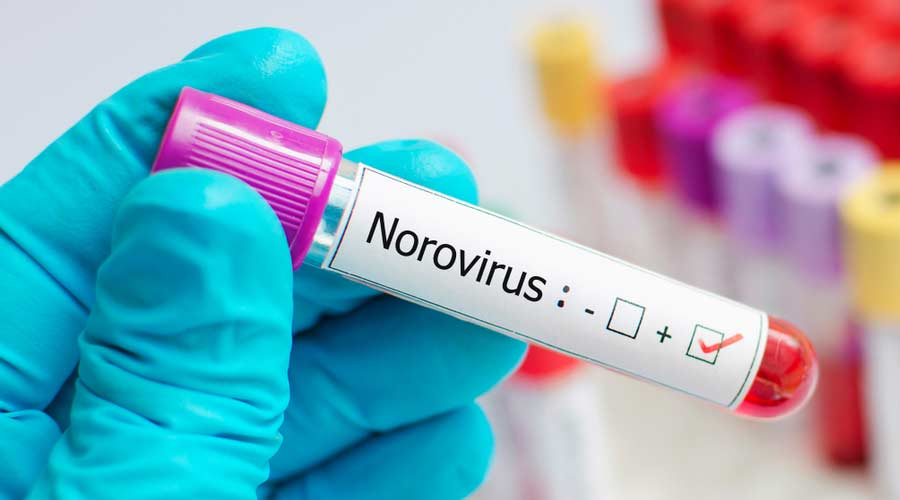Description

Copyright infringement not intended
Picture Courtesy: www.cleanlink.com
Context: Norovirus cases have been on the rise in the UK in recent weeks, with numbers being 60% higher than the same time last year.
About Norovirus
- Norovirus is a highly contagious virus notorious for causing gastroenteritis, resulting in symptoms like vomiting, diarrhoea, abdominal cramps, nausea, muscle aches, headache, fever, and sometimes chills.
- It is commonly referred to as the "stomach flu" or "winter vomiting bug," but it is important to note that norovirus is distinct from influenza and specifically causes gastrointestinal issues.
Nature of Norovirus
- Norovirus exists in numerous strains, and individuals can experience multiple infections in their lifetime due to the diversity of these strains.
- It's highly contagious and easily transmitted from person to person, primarily through:
- Contaminated Surfaces: The virus can persist on surfaces like doorknobs, countertops, or objects touched by an infected person. Contact with these surfaces and subsequent hand-to-mouth actions can lead to infection.
- Contaminated Food and Water: Norovirus can contaminate food and water during preparation or handling by an infected individual, leading to widespread outbreaks if consumed by others.
Symptoms of Norovirus Infection
- The typical onset of symptoms occurs within one to two days after exposure to the virus.
- Gastrointestinal Distress: Vomiting and diarrhoea are hallmark symptoms. These can be severe, leading to dehydration due to the loss of fluids.
- Nausea, Abdominal Pain, and Fever: Patients often experience nausea, cramping abdominal pain, accompanied by a fever, headaches, and body aches.

Transmission Routes
- Person-to-Person Contact: Close contact with infected individuals, especially through exposure to their vomit or stool, is a primary transmission route.
- Contaminated Surfaces and Objects: The virus can persist on surfaces and objects for an extended period, making transmission possible through touching contaminated surfaces and then touching the face or consuming contaminated food without proper hand hygiene.
- Contaminated Food and Water: Consumption of food or water contaminated during preparation or handling by an infected person can result in infection.
- Aerosolized Vomit or Stool: Even the air around an area contaminated with vomit or stool can potentially spread the virus.
Treatment
- There is no specific antiviral treatment for norovirus.
- There is no currently available vaccine for norovirus.
- Resting, managing symptoms, and ensuring adequate hydration to prevent dehydration are the primary focus.
- Individuals are advised to avoid certain foods and activities until they recover. Severe cases might necessitate hospitalization for intravenous fluids to prevent dehydration.
Prevention
- Frequent handwashing with soap and water is paramount in preventing infection.
- Thoroughly cleaning and disinfecting surfaces, especially in areas where infected individuals have been present.
- Ensuring proper cooking of food, particularly shellfish, and careful washing of fruits and vegetables before consumption.
- Limiting contact with sick individuals helps minimize transmission.
Complications
- Norovirus infections are typically short-lived and resolve within a few days. However, for vulnerable populations such as young children, the elderly, and immunocompromised individuals, there's a higher risk of dehydration and complications, making the illness potentially more severe.

Conclusion
- Norovirus, while highly contagious, is typically not severe. Practising good hygiene and taking precautions can significantly reduce its spread, safeguarding both oneself and others from infection.
Must Read Articles:
Norovirus: https://www.iasgyan.in/daily-current-affairs/norovirus-17
|
PRACTICE QUESTION
Q. Case Study:
A school cafeteria experienced an outbreak of gastrointestinal illness among students and staff. Symptoms included sudden vomiting, diarrhoea, and stomach cramps. The school nurse suspected Norovirus due to the rapid onset and similarity of symptoms among those affected. Investigations revealed multiple individuals showing signs of illness within a short span after eating lunch at the cafeteria.
Q. How is Norovirus primarily transmitted in this scenario?
A) Contaminated food or water
B) Airborne droplets
C) Direct contact with raw meat
D) Improper sanitation practices
Answer: A
Explanation: Contaminated food or water. In this case, the outbreak likely occurred due to the consumption of contaminated food in the cafeteria.
|
















